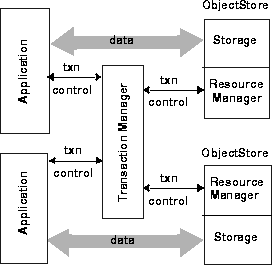Distributed Transaction Processing Model
XA is a set of services that is part of the X/Open Distributed Transaction Processing (DTP) model. The model consists of three components: an application, a transaction manager, and a resource manager.
Transaction manager
In the DTP model, transaction demarcation is controlled by a transaction manager (TM).The transaction manager can coordinate distributed transactions in multiple database systems so that, for example, one transaction can involve one or more processes and update one or more databases. The databases could be multiple ObjectStore databases or they could be incompatible databases, such as ObjectStore and Sybase.
Two-phase commit
Transactions under the control of a transaction manager are made through a two-phase commit process. In the first phase, transactions are prepared to commit; in the second, the transaction is either fully committed or rolled back.
Resource manager
An ObjectStore client acts as a resource manager (RM). Resource managers must be registered with the transaction manager.
Interface for applications
Applications are written using the transaction manager's API. XA is the interface between the transaction manager and the resource manager and is not visible to application programmers.
Transactions in the DTP Model
A global transaction is a metatransaction managed by a transaction manager and possibly involving multiple resource managers. Such transactions have globally unique identifiers generated by the transaction manager. Note that DTP global transactions are distinct from ObjectStore global transactions.A transaction branch is a transaction from a resource manager's point of view.
A global transaction can consist of many transaction branches in a mix of resource managers. Multiple branches belonging to the same global transaction can exist on a single resource manager.
XA transactions are identified by XIDs (universally unique identifiers for global transactions). A branch has a globally unique ID composed of the global transaction ID and a branch ID.
XA transactions are always of the type update.
XA is also integrated into the OMG Object Transaction Service (OTS), which is based on DTP. The examples given show the use of Iona's OrbixOTS implementation of OTS.
An application that uses a transaction manager must use the TM's interface, for example, the OMG Object Transaction Service (OTS), to begin and end transactions. Other database operations can be done using the database systems' proprietary APIs. When recovery is required, the TM manages the process, using the XA interfaces to roll back or commit transactions that were in progress.

ObjectStore clients

ObjectStore and RDBMS database
Registering ObjectStore as a Resource Manager
You must register ObjectStore as a resource manager with your transaction manager.Registering a resource manager provides basic identification information used in initialization and in processing transactions.
The information you must provide to register ObjectStore as a resource manager is packaged in a global data structure of type xa_switch_t. This data structure is defined in libos with the name ObjectStore_xa_switch.
In addition, for each ObjectStore resource manager, you must identify the hosts that will run ObjectStore Servers for applications that use the transaction manager.
There are several ways to register a resource manager. See your individual vendor documentation for specific information.
The Encina::Server::
RegisterResource function
The next example uses the OrbixOTS as the transaction manager and describes how to register a resource manager by passing a set of arguments to the Encina::Server::RegisterResource function. Information for the following parameters is required:
Intialization Example
The following example illustrates sample initialization code.